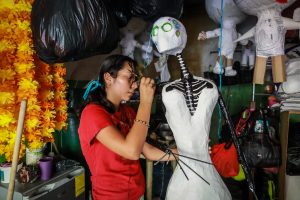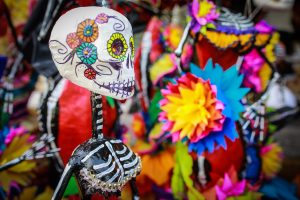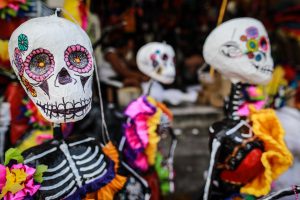
By Salma Kaufman
Acapulco, Mexico, Oct 27 (EFE).- The “Catrina,” one of the most iconic symbols in Mexican culture, has merged with another tradition – piñatas – in a clever reinvention that seeks to revamp the Day of the Dead celebration to current circumstances.
“We don’t make the Catrina piñatas using the same technique as conventional piñatas. We make them using the papier mache technique. They are handicrafts made and conceived for this season,” Anabel Real Cornejo, one of the creators of the new piñatas, told EFE on Wednesday.
Catrina is the name of the female skull that is one of the icons of the Day of the Dead festivities, although it is not a “gruesome” image, but rather one that is often decorated with colorful flowers and other bright and cheerful elements.
Although during the entire year, and especially during the Christmas season, the seven-pointed piñata – representing the seven major sins – is the one that is most in demand, the Alegria Piñateria, located in Acapulco, wanted to innovate and rescue a portion of the Day of the Dead culture surrounding the iconic holiday running from Oct. 31 through Nov. 2.
The production of Catrina piñatas began four years ago and now it has become – at least in this coastal resort city – an important feature of many Day of the Dead altars and festivals.

Before, piñatas with Halloween themes were popular “but when we began to see the need to rescue our traditions” the piñata company decided to focus on something inherently Mexican, Anabel said.
These days, at this piñata factory in Acapulco, the Catrina figures are being turned out along with all sorts of other piñatas: animated characters and film personalities, politicians like former President Enrique Peña Nieto and even one looking like the coronavirus, which has been a big seller in recent months.
Over the years, piñatas have become one of the most representative elements of Mexican culture.
Although some historians believe that they were brought to Europe by Marco Polo after his travels in China, and from there to Mexico by missionaries, others say that piñatas originated among the Aztec, Maya and other pre-conquest Mexican civilizations, which made clay pots and hollow sculptures representing their gods.
In those cases, piñatas were used in religious festivals and rites.
Despite not knowing how customers would react to the new piñata, the company – where six women and a handful of young people currently work – decided to forge ahead with their new creation by turning out an initial batch of 20 Catrina piñatas.
“We made one and that was enough. That first year it was really crazy. They snapped up the Catrina and we began to get requests for it. But we couldn’t produce all that people were demanding,” Anabel said.
For Mexicans, Catrina is more than just a nicely dressed skull.
Created at the beginning of the 20th century by engraver and illustrator Jose Guadalupe Posada, at first it was also known as the Little Skull and alluded to a social criticism mocking indigenous people who had enriched themselves and slighted their origins and customs.

Making each of these piñatas, Anabel said, takes about 11 months.
First, the bases and the bodies are made and then the head, hands and fingers are molded. Later, the figures are painted and adorned with a personalized design for each one.
“They’re are worked on with a lot of lead time to be able to get them ready and so they’ll be dry and presentable for the season. They’re made with painting with the most delicate detail we can give them. It’s all painted by hand,” the artist said.
Currently, the Catrina piñatas come in four different sizes ranging from 35 centimeters (14 inches) high to 2.5 meters (about 8.3 feet).
As she is currently conceived, Catrina celebrates life after death and creates a link between those two states, thus idealizing in a certain way the rituals of the Day of the Dead in Mexico.
“I know that it’s a very difficult question. The reason we acquire them is very sad, above all, but at the end of the day it’s the way in which we remember our dead (loved ones) on the altars,” Anabel said.
In the past, the piñatas turned out by the company have been very successful and have been sold not just locally but also in other Mexican states like Puebla and Morelos.
Because of the Covid-19 pandemic, the piñata workshop estimates that its sales have plunged by 60 percent.
Nevertheless, they are confident that they can recover their sales and, although the cemeteries are closed to the public in many regions of the country due to the pandemic, or have very limited access, the Catrina piñatas have been used to adorn many semi-shrines to the dead in private homes.
“People come to buy them because it’s still the tradition to make them offerings to the dead. And sadly, the figures for deaths have increased,” she said.
Now more than ever, Anabel said, it’s important to continue with longstanding traditions, since it brings happiness to the home.
“Breaking a piñata is part of living together. For us, it’s fundamental to have a Catrina because we know we’re going to die and we’re remembering,” she said.
To date, Mexico has suffered more than 860,000 confirmed coronavirus cases and 86,893 Covid-19 deaths.

The Day of the Dead (in Spanish: Dia de Muertos) is a Mexican public holiday celebrated throughout Mexico, and by people of Mexican heritage elsewhere. The multi-day holiday – coinciding with Oct. 31 through Nov. 2, or All Saints’ Eve, All Saints’ Day and All Souls’ Day, in the Christian tradition – involves people gathering to pray for and remember friends and family members who have died, and helping support their spiritual journey.
In Mexican culture, death is viewed as a natural part of the human cycle. Mexicans view it not as a day of sadness but as a day of celebration because their loved ones awaken and celebrate with them. In 2008, the tradition was inscribed in the Representative List of the Intangible Cultural Heritage of Humanity by UNESCO.
